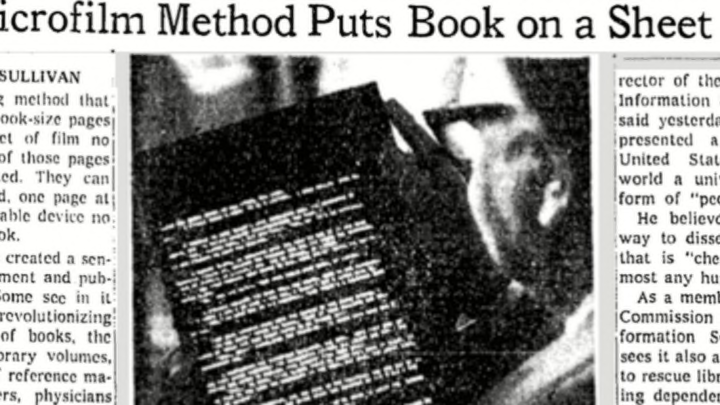In 1972, two scientists excitedly announced the development of a new technology that, according to a New York Times page one story, caused a "sensation in...publishing circles." It was predicted to perhaps "revolutionize the publication of books," and an information-processing specialist for the Navy said it could "eliminate central files in large bureaucracies" and "'re-make' the information handling industry."
The magic technology was a new kind of microfilm, and it didn't do any of those things. However, the devices that did manage to successfully conquer the publishing industry and revolutionize the way we handle information wound up looking pretty similar to this gadget from the early '70s.
The microfilm, which was invented by Adnan Waly and George J. Yevick, stored 625 pages of text per sheet and could be displayed one page at a time on a portable device. This machine, which looked somewhat like a modern e-book, was “powered either by a portable battery unit or by plugging into an electric outlet.”
The process of uploading the books to the microfilm sheets involved photographing the pages through thousands of tiny lenses (like a "fly's eye"), and, had the reader hit the market, each sheet would have cost around 25 cents to buy. The inventors imagined cigarette machine-like dispensers placed around the planet that would sell books for use on their little handheld reader. Waly and Yevick hoped that it would become a "people's technology" and make the world's information "cheap enough for almost any human being" to access.
The invention also had an advantage over plenty of modern tablet computers. According to one of Waly and Yevick's original patents, "this projection display device has proved to be surprisingly immune to image wash-out by ambient light" based on tests performed in brightly lit rooms. (Their technology would later be cited in patents for early LCD displays.)
The microfilm and corresponding reader never caught on, and the invention faded away after that first major story on the front page of the New York Times. The parallel development of early personal computers by companies like XEROX overshadowed Waly and Yevick's little machine and likely prevented it from ever getting off the ground.
Even the most clever technologies that perfectly predict the flow of modern development often wind up as footnotes to footnotes in the stories of other inventions, barely even allowed the opportunity to be made obsolete.
